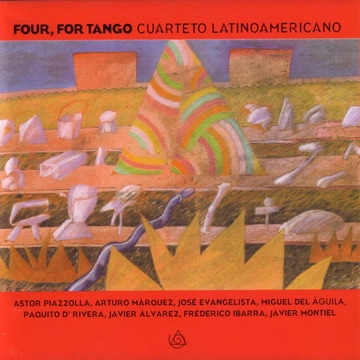|
Four, for tango
String quartets by Astor Piazolla, Arturo Marquez, Jose Evangelista, Miguel del Aquila, Paquito d’Rivera, Javier Alvarez, Frederico Ibarra, Javier Montiel The Cuarteto Latinoamericano has been deeply invested in performing the cycle of composers of Latin American heritage around the world for the past few decades. On a given night on a concert stage they will perform works from these composers -- as well as Silvestre Revueltas from Mexico, Héitor Villa-Lobos from Brazil, Alberto Ginastera from Argentina and many others -- works which lift expression from the popular and folkloric toward a variable abstraction, work of powerful individuality, which is the musical relative of literature's magical realism, and which Ginastera referred to as imaginary folklore. José Evangelista (born in Valencia, Spain) resides in Montreal, Canada where he is a professor and founder of the Balinese gamelan workshop at the University of Montreal, and a resident composer of the Montreal Symphony Orchestra. Spanish Garland is made up of twelve folkloric melodies, mostly very ancient and from Spain's very different Islamic regions. The styles come from the Muslims, from India, from the gypsies and from the memory of the virtuosity of Pablo de Sarasate. Astor Piazzolla (1921-1992) took the tango from a popular dance form and from it made art. Four, for Tango (1987) contains remarkable instrumental vigor, powerful rhythm, and aggressive and passionate sonorities with a characteristic taste of Buenos Aires nostalgia. Considered by the international press as "one of the most outstanding composers of South America," Miguel del Águila was born in Montevideo, Uruguay in 1957 and studied there, in Vienna, Los Angeles and San Francisco. Presto No. 2, written for and premiered by the Cuarteto Latinoamericano, is a Latin dance of never-ending movement. The candid and swinging theme insinuates itself with pizzicatos, progresses in crescendo and bursts into an agitated scherzo to arrive at a climax that involves a hilarious wink toward Ravel's La Valse. The musicologist Yolanda Moreno Rivas wrote of Javier Álvarez (b. 1956), "He is probably the most interesting Mexican musician born in the '50s." Álvarez has written various pieces commissioned by and named after the Mexico City Metro system. Metro Taxqueña imagines a late night itinerary, with only a few travelers in the cars, and a somber and melancholic meditation sliding down the windows. Paquito d'Rivera (b. 1948) former member of the Cuban group Irakere, saxophone virtuoso and fundamental figure of Latin jazz, has toured the world and recorded profusely. Written in the '70s and inspired by the music of the Yucatan Peninsula in Mexico, Wapango relates to the orchestral work by Moncayo called the Huapango. Arturo Márquez (b. Mexico, 1950) is a composer of luxuriant imagination and has experimented frequently with the dialogue between concert and popular music of the Caribbean and Latin American origins. Homenaje a Gismonti, which honors the Brazilian musician Egberto Gismonti, was written in 1993 for the Cuarteto Latinoamericano by request of the San Miguel de Allende Chamber Music Festival. The composer was inspired by the music of the Huasteca people who performed at the San Joaquin, Queretaro, Festival. Some of the melodic and rhythmic bow strokes are suggested by the Huastecan sones, and a cello solo is in honor of Gismonti. A leader among the current generation of Mexican composers, Frederico Ibarra (b. 1946) works in chamber, symphonic music and opera. The String Quartet No. 2, Órfico, also commissioned by the San Miguel de Allende Chamber Music Festival, is divided into three movements. His compositions are characterized by a deep and eclectic assimilation of modern and contemporary techniques and languages, and by an emotional impact that frequently reaches dramatism. Few themes in history have been as known as Niccolo Paganini's Caprice No. 24 for solo violin. The variations by Javier Montiel -- composer and violist of the Cuarteto Latinoamericano -- have evolved into the Cuarteto's preferred encore. Going from enunciation to ironic insinuation, from neo-classicism to contemporary instrumental resources, Montiel's variations are clearly rooted to the end of the 20th Century. Available here: iTunes Comments are closed.
|
New Albion Records, Inc.Archives
October 2010
|

